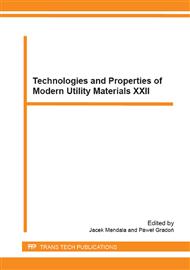p.127
p.133
p.137
p.143
p.149
p.155
p.161
p.167
p.173
The Influence of High Velocity Thermal Spraying Methods on Top Surface Topography of WC-Co Coatings
Abstract:
Characterization of top surfaces of WC-Co coatings obtained during deposition process of high velocity thermal spraying type was showed in this article. The feedstock powder was so called “superfine” powder of WC-17Co types produced by Inframat. In first part of article short characterization of powder was presented, especially characterization of it morphology including shape, internal microstructure and grain size description. The second part of article is dedicated to characterization of microstructure and topography of top surface of coatings deposited by two different methods of high velocity thermal spraying. In this case analysis of top-surface condition by scanning microscopy with chemical analysis in microareas was used and as well as a qualitative and quantitative analysis of topography of carbides surface by traditional non-contact and laser profilometry.
Info:
Periodical:
Pages:
149-154
Citation:
Online since:
January 2015
Authors:
Keywords:
Price:
Сopyright:
© 2015 Trans Tech Publications Ltd. All Rights Reserved
Share:
Citation:


